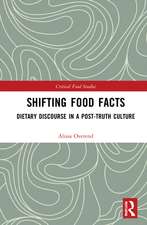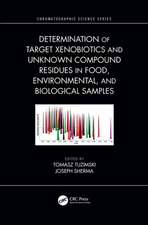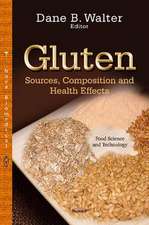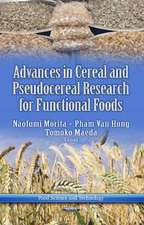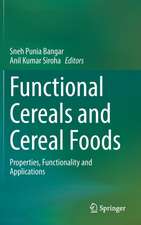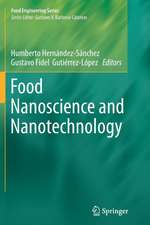Faba Bean: Chemistry, Properties and Functionality
Editat de Sneh Punia Bangar, Sanju Bala Dhullen Limba Engleză Paperback – 19 noi 2023
Faba bean Chemistry, Properties and Functionality studies the global status and production of faba bean food products plus their agronomy, nutritional value and potential medicinal applications. The agrarian conditions are studied in full, asare postharvest practices. The chemical makeup of faba bean is a major focus, especially in relation to nutrient composition and quality. Chapters in this text focus on anti-nutritional attributes, antioxidants and bioactive compounds plus the effects of processing, storage and cooking on their nutritional value. Starch and its modification, structure, properties and industrial applications are covered, as is protein, genetic improvement and functional product formulation. The text also looks at the future perspectives of this valuable plant and food source. To date, no reference works have exclusively covered faba bean. This book provides a much-needed single source reference point for researchers looking to gain knowledge on this important plant and its use in high protein, health-beneficial food products.
| Toate formatele și edițiile | Preț | Express |
|---|---|---|
| Paperback (1) | 1385.67 lei 6-8 săpt. | |
| Springer International Publishing – 19 noi 2023 | 1385.67 lei 6-8 săpt. | |
| Hardback (1) | 1391.83 lei 6-8 săpt. | |
| Springer International Publishing – 19 noi 2022 | 1391.83 lei 6-8 săpt. |
Preț: 1385.67 lei
Preț vechi: 1689.85 lei
-18% Nou
Puncte Express: 2079
Preț estimativ în valută:
265.16€ • 283.54$ • 221.08£
265.16€ • 283.54$ • 221.08£
Carte tipărită la comandă
Livrare economică 17 aprilie-01 mai
Preluare comenzi: 021 569.72.76
Specificații
ISBN-13: 9783031145896
ISBN-10: 3031145895
Pagini: 397
Ilustrații: XIII, 397 p. 40 illus., 30 illus. in color.
Dimensiuni: 155 x 235 mm
Greutate: 0.58 kg
Ediția:1st ed. 2022
Editura: Springer International Publishing
Colecția Springer
Locul publicării:Cham, Switzerland
ISBN-10: 3031145895
Pagini: 397
Ilustrații: XIII, 397 p. 40 illus., 30 illus. in color.
Dimensiuni: 155 x 235 mm
Greutate: 0.58 kg
Ediția:1st ed. 2022
Editura: Springer International Publishing
Colecția Springer
Locul publicării:Cham, Switzerland
Cuprins
1-Introduction: Global Status and Production of Faba-bean.- 2-Agrarian conditions and post-harvest practices of Faba bean.- 3-Physical and Milling Characteristics of Faba-Bean.- 4-Chemistry, Nutrient composition and Quality of Faba Beans.- 5-Faba-Bean: Chemistry, Properties, and Functionality.- 6-Faba-bean Antioxidant and Bioactive Composition: Biochemistry and Functionality.- 7-Effect of processing on the nutrients and anti-nutrients of faba-bean.- 8-Effect of Storage on Quality and Cooking Attributes of Faba Bean.- 9-Faba bean starch: structure, physicochemical properties, modification, and potential industrial applications.- 10-Faba Bean Proteins: Extraction Methods, Properties and Applications.- 11-Biofortification: Quality improvement of Faba Bean.- 12-Faba Bean Utilization: Past, Present and Future.- 13-Current and Potential Health Claims of Faba Beans (Vicia faba, L.) and its components.- 14-Disease Management of Faba Beans.
Notă biografică
Sneh Punia Bangar, Ph.D., is a researcher at Clemson University, United States. Earlier, she worked as Assistant Professor (C) in the Department of Food Science and Technology, Chaudhary Devi Lal University, Sirsa. Her research interests include extraction and functional characterization of bioactive compounds, starches, functional foods, and nanocomposites films and coatings. She has presented her research at various national and international conferences and has published more than 100 research papers/book chapters in national and international journals/books. To date, she has authored or co-authored more than 100 (published/accepted), one book series, 2 authored books (CRC, Taylor, and Francis), 5 edited books (CRC Taylor and Francis, Springer, Elsevier), one reference book (CRC, Taylor, and Francis), 35 book chapters, 20 conference proceedings/seminars, and 3 Guest Editor of Journals special issues (Food Research International, International Journal of Food Science and Technology, Journal of Food Processing and Preservation, Foods and Polymers).
Sanju Bala Dhull, Ph.D., is presently working as an Associate Professor in the Department of Food Science and Technology, Chaudhary Devi Lal University, Sirsa, having more than 14 years of teaching and research experience. Her area of interest includes characterization and modification of biomolecules such as starch, gums, edible films, hydrogels, nanoparticles, nanoemulsions, and new product development. She has published more than 40 research papers, 3 books, and 20 book chapters in national and international repute books. She has presented more than 20 research papers in various national and international conferences. She is a life member of the Association of Food Scientists and Technologists (India) and the Association of Microbiologists of India. She also serves as an editorial board member and reviewer of national and international journals.
Sanju Bala Dhull, Ph.D., is presently working as an Associate Professor in the Department of Food Science and Technology, Chaudhary Devi Lal University, Sirsa, having more than 14 years of teaching and research experience. Her area of interest includes characterization and modification of biomolecules such as starch, gums, edible films, hydrogels, nanoparticles, nanoemulsions, and new product development. She has published more than 40 research papers, 3 books, and 20 book chapters in national and international repute books. She has presented more than 20 research papers in various national and international conferences. She is a life member of the Association of Food Scientists and Technologists (India) and the Association of Microbiologists of India. She also serves as an editorial board member and reviewer of national and international journals.
Textul de pe ultima copertă
Faba bean is a species of flowering plant in the Fabaceae family and the fourth most widely grown winter season legume after pea, chickpea, and lentil. The nutritional profile of faba beans is excellent as they contain an adequate quantity of proteins, carbohydrates, vitamins, minerals and various polyphenols. Faba bean seeds are a rich source of carbohydrates and starch. Because of higher amylose content than cereal starches, legume starches provide distinctive properties such as high gelation temperature, fast retro-gradation, high resistant starch and gel elasticity to food systems. Faba bean has been a beneficial source of protein in food products worldwide for centuries and continues to be highly produced and consumed to this day.
Faba bean Chemistry, Properties and Functionality studies the global status and production of faba bean food products plus their agronomy, nutritional value and potential medicinal applications. The agrarian conditions are studied in full, as are postharvest practices. The chemical makeup of faba bean is a major focus, especially in relation to nutrient composition and quality. Chapters in this text focus on anti-nutritional attributes, antioxidants and bioactive compounds plus the effects of processing, storage and cooking on their nutritional value. Starch and its modification, structure, properties and industrial applications are covered, as is protein, genetic improvement and functional product formulation. The text also looks at the future perspectives of this valuable plant and food source. To date, no reference works have exclusively covered faba bean. This book provides a much-needed single source reference point for researchers looking to gain knowledge on this important plant and its use in high protein, health-beneficial food products.
Faba bean Chemistry, Properties and Functionality studies the global status and production of faba bean food products plus their agronomy, nutritional value and potential medicinal applications. The agrarian conditions are studied in full, as are postharvest practices. The chemical makeup of faba bean is a major focus, especially in relation to nutrient composition and quality. Chapters in this text focus on anti-nutritional attributes, antioxidants and bioactive compounds plus the effects of processing, storage and cooking on their nutritional value. Starch and its modification, structure, properties and industrial applications are covered, as is protein, genetic improvement and functional product formulation. The text also looks at the future perspectives of this valuable plant and food source. To date, no reference works have exclusively covered faba bean. This book provides a much-needed single source reference point for researchers looking to gain knowledge on this important plant and its use in high protein, health-beneficial food products.
- Provides Extensive knowledge on the nutritional aspects as faba bean and fabaa bean food products;
- Contains a wealth of new information on the structure, functional and antioxidant properties of faba bean;
- Covers the latest developments in the modification of native starches.
Caracteristici
Provides Extensive knowledge on the nutritional aspects as faba bean and fabaa bean food products Contains a wealth of new information on the structure, functional and antioxidant properties of faba bean Covers the latest developments in the modification of native starches







